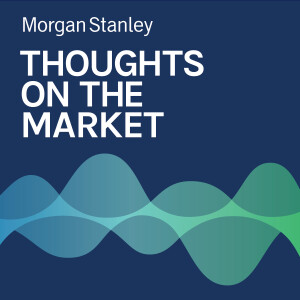
As the infrastructure needs for artificial intelligence soar, so does the need for financing. Our Chief Fixed Income Strategist talks about the role credit markets can play in providing capital to power the sector.
----- Transcript -----
Welcome to Thoughts on the Market. I am Vishy Tirupattur, Morgan Stanley’s Chief Fixed Income Strategist. Along with my colleagues bringing you a variety of perspectives, today I'll be talking about the role of credit markets in the artificial intelligence (AI) revolution.
It's Thursday, June 27th at 1 pm in New York.
Technology diffusion driven by artificial intelligence has been a defining theme for investors over the last few years. Recent developments in generative AI, or GenAI powered by large language models, have the potential to bring transformational changes across the economy. Today, I want to talk about the role of credit markets in this AI revolution.
The infrastructure requirements of AI – semi fabs, data centers and the energy resources to power the Gen AI models – are enormous. Our analysts estimate that GenAI power demand will rise rapidly, reaching 224 Trillion Watt hours by 2027 in their base case which is roughly close to Spain's total 2022 power consumption.
So, it goes without saying that AI infrastructure will need substantial capex. Early on, much of the AI capex has been funded by a combination of venture capital and retained earnings from cash-rich technology companies; in other words funded by equity capital. As the focus shifts from early innovators and enablers of AI to adopters of AI, these needs are bound to grow and will require more efficient forms of capital. We think that credit markets in various forms – unsecured, secured, securitized and asset-backed – will have a major role to play in this transformation.
So far, debt financing has played a relatively small part in funding technology companies, especially AI beneficiaries. The sector has significant capacity to add debt without a material deterioration in their credit metrics. This capacity is also complemented by an investor base with a significant dry powder to absorb incremental issuance, thereby avoiding a demand-supply mismatch.
Of course, the story is not that simple. Cash-rich companies may not have a compelling need to access credit markets if the equity market continues to reward redirection of these free cash flows. But then the path of the interest rate markets will also matter, as monetary policy eases, the cost of debt becomes incrementally even more attractive. It’s clearly early innings, but credit markets holistically should play a bigger role as the cycle matures.
In addition, as the capex cycle broadens out from enablers to adopters, we note that most sectors are nearly not as cash-rich as the technology sectors. For example, the median cash to debt ratio for the technology sector is over 50 percent, but then for the remaining sectors, it is just 15 percent. So as capital needs driven by these infrastructure needs increase, we expect the reliance on credit markets also to increase.
In some ways, this has already begun to happen. The first data center asset backed security was issued in 2018. The market has now grown to over 20 billion outstanding and it is poised for a rapid growth. The bottom line is simply this: As AI driven technology diffusion takes center stage, credit markets, broadly defined, will likely play a growing role. As always, there will be winners and there will be losers. But AI as a theme for credit investors is here to stay.
Thanks for listening. If you enjoy the podcast, please leave us a review wherever you listen and share Thoughts on the Market with a friend or colleague today.
More Episodes
 2024-07-16
2024-07-16
 2024-07-15
2024-07-15
 2024-07-11
2024-07-11
 2024-07-10
2024-07-10
 2024-07-08
2024-07-08
 2024-06-28
2024-06-28
 2024-06-25
2024-06-25
Create your
podcast in
minutes
- Full-featured podcast site
- Unlimited storage and bandwidth
- Comprehensive podcast stats
- Distribute to Apple Podcasts, Spotify, and more
- Make money with your podcast
It is Free
- Privacy Policy
- Cookie Policy
- Terms of Use
- Consent Preferences
- Copyright © 2015-2024 Podbean.com





